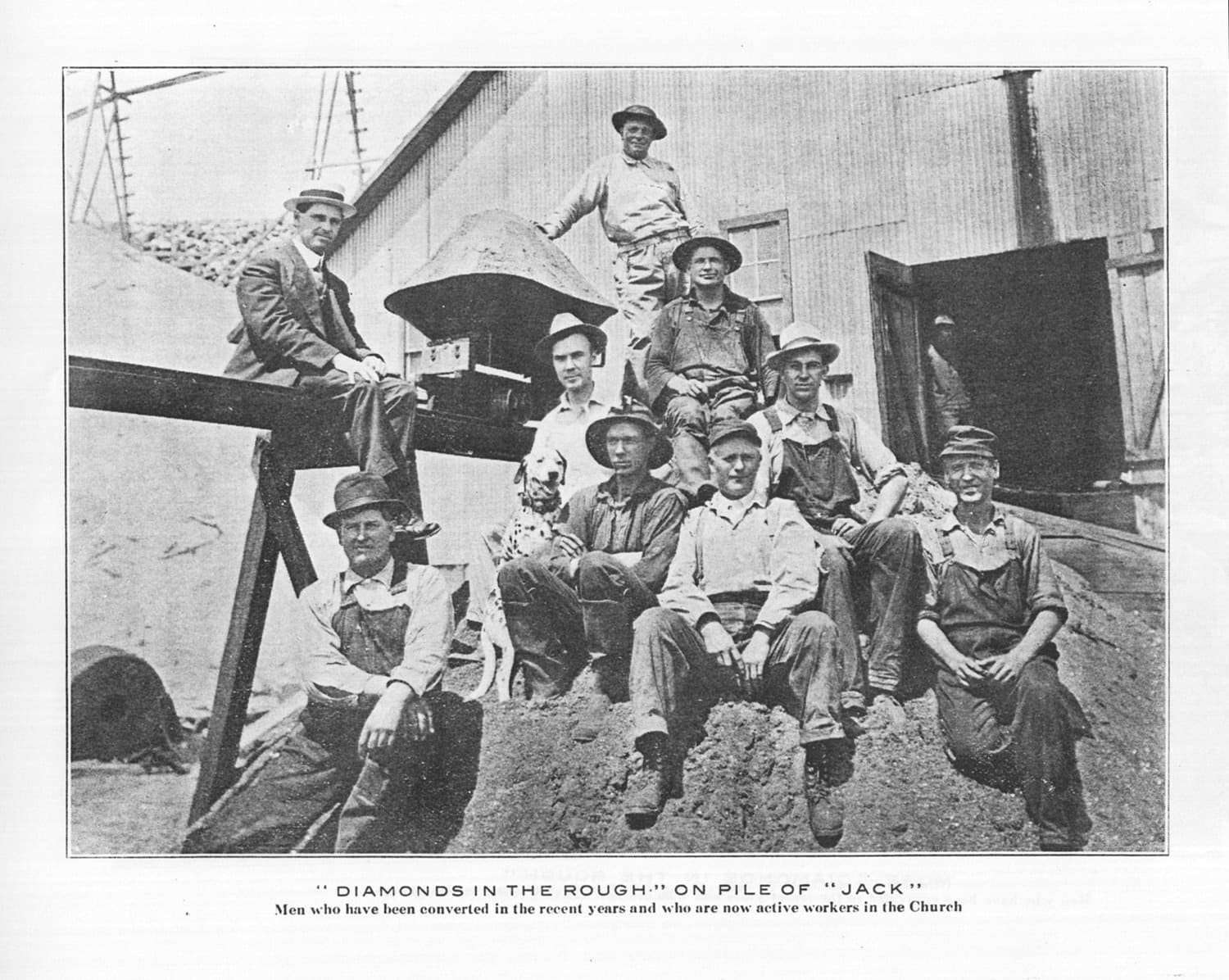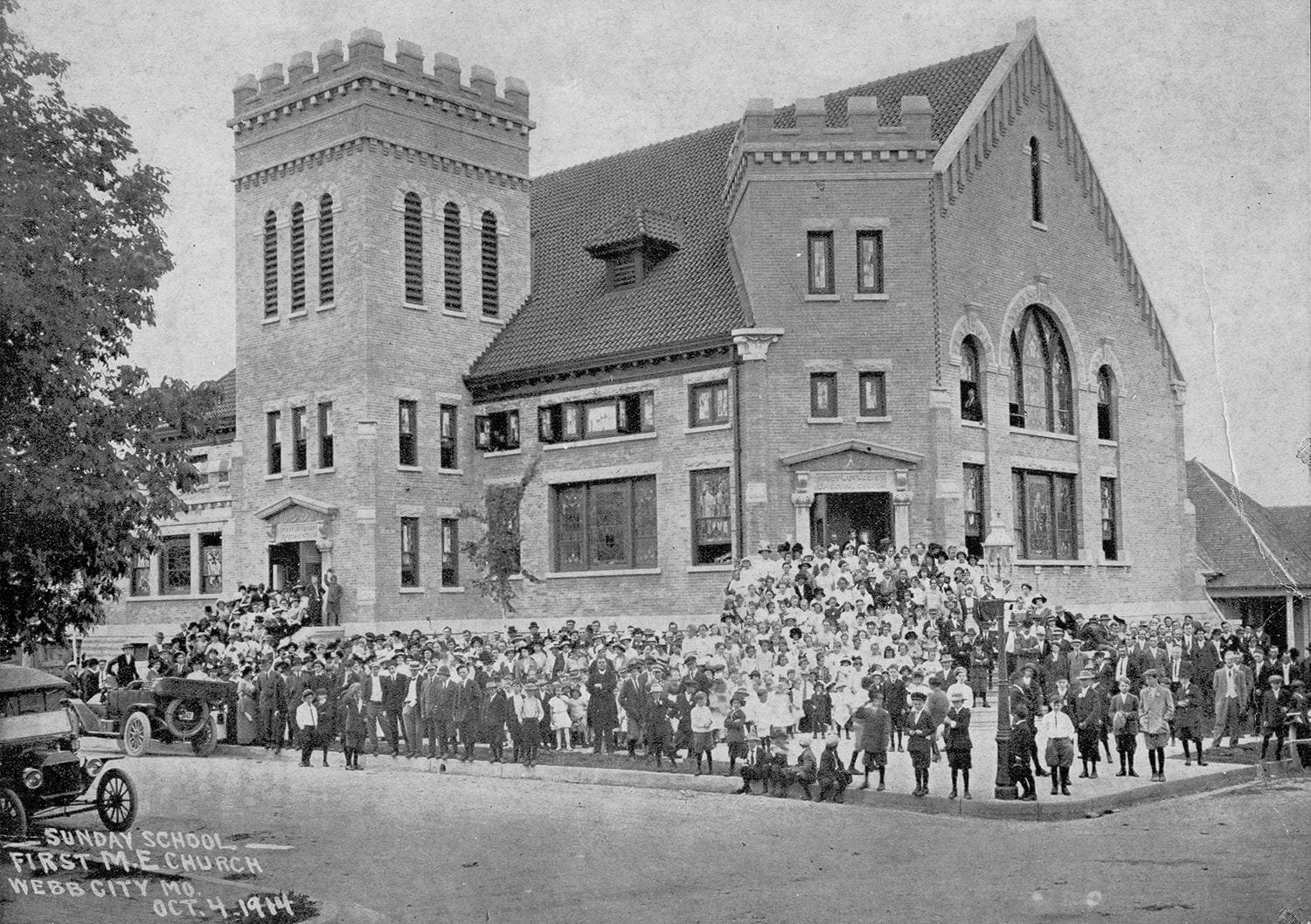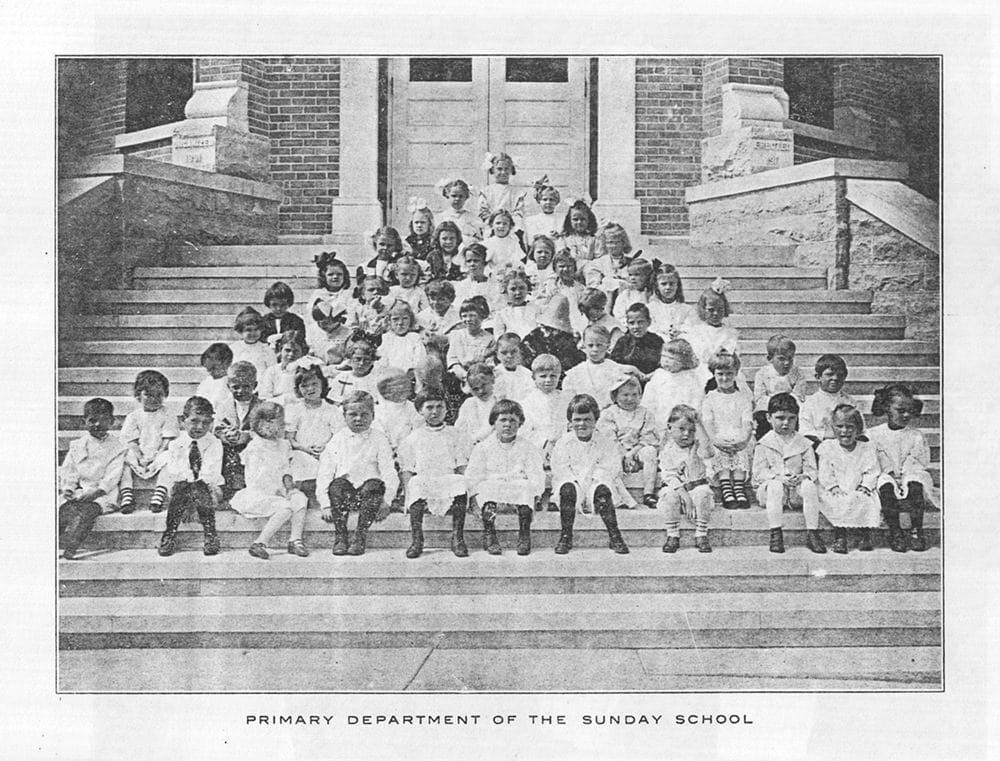
These are some of the “Diamonds in the Rough” miners saved by the Rev. Dean Dutton as he built membership in the First Methodist Episcopal Church.
First Methodist congregation “exploded” with the mines
NOTE: This partial reprint article is a logical continuation of the one last week about a chain reaction of church changes in 1941.

Three years after its dedication, First Methodist was bursting with members of all ages. (VICK CARIS PHOTO)
 The auction in 2015 at the large church on the southwest corner of Oronogo and Second streets was cause for the Webb City Area Genealogical Society to look back at the building’s history.
The auction in 2015 at the large church on the southwest corner of Oronogo and Second streets was cause for the Webb City Area Genealogical Society to look back at the building’s history.
It was built by the First Methodist Episcopal Church for $45,000 and dedicated on Sept. 17, 1911.
A newspaper reported that the church’s membership grew from 200 to 700 from 1909 to 1910. The new church was the sixth building occupied by the church.
The parsonage, a brick building across Oronogo Street, was built at the same time as the church.
The 1939 merger of the Methodist Episcopal Church and Methodist Episcopal Church, South, led Webb City’s two Methodist churches to join. The congregation at Oronogo and Second streets moved to Central Methodist Church, at Broadway and Pennsylvania Street.
Sacred Heart Catholic Church bought the abandoned building and held services there from 1940 to 1982, when the present church on North Madison Street was completed.
Ken and Joan Hughes bought the church when they moved here from Riverside, Calif. in 1994. They had been traveling in search of a church for their Abundant Life Ministry when they came across the vacant building at Second and Oronogo streets. They named it the Stone Castle Church and conducted services there until Ken became ill. He passed away in 2010, and Joan died April 20, 2015.
The following was written for the church’s dedication in 1911:
This city, located in the great mining district of Southwest Missouri, is a town of 12,000 people, all American. It is the largest “dry” city in the state.
The live, young, conservative business men of the First Methodist Episcopal Church saw an opportunity to do large things for God. Their vision has been wonderfully realized. The little old church has given way to a most beautiful modern building, which will accommodate 1,000 persons. It has a full basement, steam heat, fine Sunday School quarters, is finely located, and is doing great business. It has three live mission Sunday Schools. All church membership is held at the central plant where all worship on the Lord’s day. The membership has increased from 250 to close to 700. The church is very much united and harmonious in its work. The congregations are large, both morning and evening. The congregational singing is wonderful. The prayer meetings, study classes and cottage meetings are well attended and full of a deep, well-poised religious fervor of the most beautiful type.
The work of this church in Webb City has only just nicely gotten started.
Dean C. Dutton is the pastor.


The following, which was part of the Webb City Historical Society’s exhibit on Webb City churches, provides more information about why there were two Methodist churches in the first place.
The Methodist Church, South, benefited from city founder John C. Webb’s membership when he gave the small group a choice lot for the construction of their church in 1881. A small brick church was built at the southeast corner of Liberty and Broadway.
In 1909, E.T. Webb (son of John C. Webb) spearheaded the construction of a new much larger building at the southeast corner of Broadway and Pennsylvania Street, where his horse barn had previously been located. The “great stone edifice” had a final cost of $80,000 and seated 900 people in its “tabernacle.” Built to double as a community assembly, the church served as the site for state meetings and high school graduations for many years. Even before dedication, the building was used for the state YMCA convention.
The Methodist Church, North, was only a year behind in its building program, erecting a two story frame building at the northeast corner of Webb Street and Broadway. Always the larger of the two denominations in Webb City, the North church soon outgrew their building and undertook the erection of a brick structure still standing on the southwest corner of Oronogo and Second streets. “Attendance in those days overflowed even this big church as the Rev. Dutten went into the mining fields and visited with his boys in every mill and mine. He called them his diamonds in the rough, and the organization grew so fast that mission churches were built and they thrived until the mining decline set in.”
The two churches joined together using the South church’s building when the national denominations finally mended the breach in 1940. It had taken a long time to heal the wounds of the Civil War. At the time of the consolidation, the sanctuary was remodeled to suit contemporary tastes, the pipe organ dismantled and replaced by an electric organ, the balconies closed off into permanent classrooms reducing the seating capacity of the sanctuary to a number closer to the actual membership of the church. At the time of reunification, First Methodist Church (North) brought 450 members, while Central (South) brought 260.
This blog article, “How the Methodist Church split in the 1840s,” tells about the debate over slavery within the church nationally.
For the latest information about the Webb City Area Genealogical Society, visit its Facebook page.
Everything you want to know about Jasper County Missouri Schools is available at a site compiled by Webb City Area Genealogical Society member Kathy Sidenstricker.
The Webb City Sentinel isn’t a newspaper – but it used to be, serving Webb City, Missouri, in print from 1879-2020. This “newspaper” seeks to carry on that tradition as a nonprofit corporation.
© All Rights Reserved 2024
DIY website design by Bob Foos